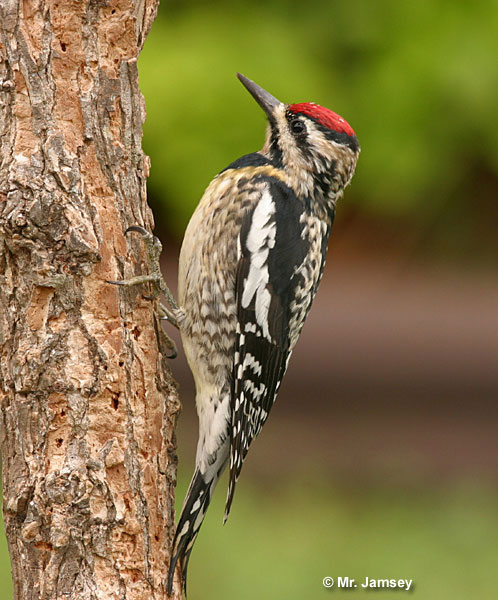The Yellow-bellied Sapsucker is a smaller-sized woodpecker. They have long wings that extend past the end of their tail and straight, stout bills. In the eastern portions of North America, you may have seen rows of shallow holes in trees.
Yellow-bellied Sapsuckers make these holes. These resourceful birds consume any trapped insects and leaking sap with their unique, brush-tipped tongue.
Yellow-bellied Sapsuckers inhabit young deciduous forests. If you see a neatly organized, distinct row of sap wells, you’ll know if you’re in a Yellow-bellied Sapsucker’s territory.
You’ll commonly see them perched on the end of tree branches, hunting for insects or managing their sap wells.
On this page
Breeding Male
Yellow-bellied Sapsuckers are almost entirely black and white and have strong face patterns. Males and females have red on their foreheads; however, males also have red throats.
Additionally, they have long white stripes along their wings and bold black-and-white stripes that curve from the face toward yellowish or white underparts and black chest shields.
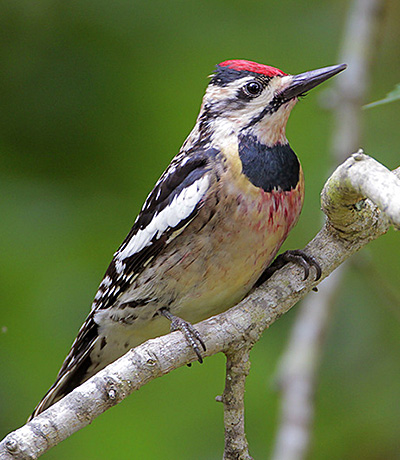
These birds are 7.1 to 8.7 inches (18 to 22 centimeters) long and weigh 1.5 to 1.9 ounces (43 to 55 grams).
They’re a little bit smaller than a Hairy Woodpecker and bigger than a Downy Woodpecker.
Female
Female Yellow-bellied Sapsuckers look almost identical to breeding male Yellow-bellied Sapsuckers. Females lack the red throats that males have.
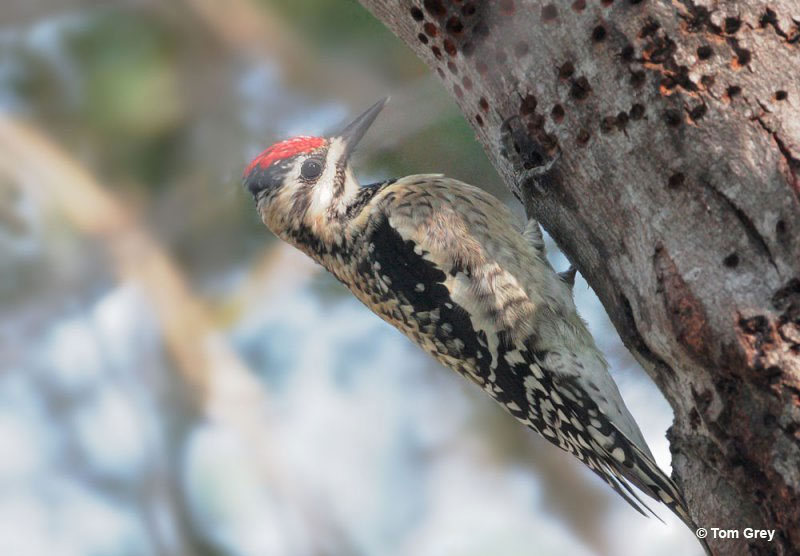
Female. Photograph © Tom Grey
Juvenile
Juvenile Yellow-bellied Sapsuckers are mostly brown and have some of the black-and-white patterns that adults have. Additionally, they have vertical white wing patches and a lightly spotted crown.
It takes 10 to 13 days for these birds to hatch, and they’ll leave the nest after 25 to 29 days. The parents will teach the young how to consume sap and feed them for around 10 days after leaving the nest.
Habitat
The Yellow-bellied Sapsucker will favor edge habitats and young forests in spring and summer. In these areas, they can find fast-growing trees that are perfect for sap wells.
Unlike most species of woodpeckers, sapsuckers don’t depend on dead trees for food. However, they will search for dead limbs or decayed heartwood on trees for their nesting cavities. In their wintering grounds, these sapsuckers aren’t as picky when it comes to habitat.
They inhabit bottomland hardwood forests to habitats as high as 10,000 feet. Additionally, these birds inhabit forests of pines, oaks, or hickory.
Diet
Yellow-bellied Sapsuckers’ main source of food is sap. They drill wells in trees in the early spring. These wells are precisely organized so that the holes are in horizontal rows.
First, Yellow-bellied Sapsuckers will drill circular, narrow wells into the inner part of the tree’s trunk. Next, after the tree leafs out, the birds will begin to make rectangular, more shallow wells in the part of the tree’s trunk that carries the sap from the leaves. These wells have to be maintained continuously to keep the sap flow going.
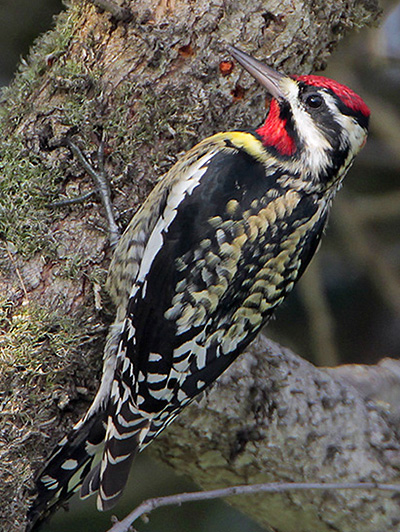
These birds tend to choose wounded or sick trees for drilling and will choose species of trees that have high sugar concentrations. Some of these trees include yellow birch, paper birch, sugar maple, hickory, and red maple. Sap can be more than 10 percent sugar. Yellow-bellied Sapsuckers will also eat insects, mainly spiders, and ants, from underneath a tree’s bark.
Yellow-bellied Sapsuckers also visit orchards, where they eat fruit and drill wells in the trees.
Behavior
Yellow-bellied Sapsucker pairs will engage in spirited pre-courtship behavior at the beginning of spring before mating begins. Courting birds will land on a tree branch and face each other with throat feathers fluffed out, crest feathers raised, tails and bills raised, and swing their heads from side to side.
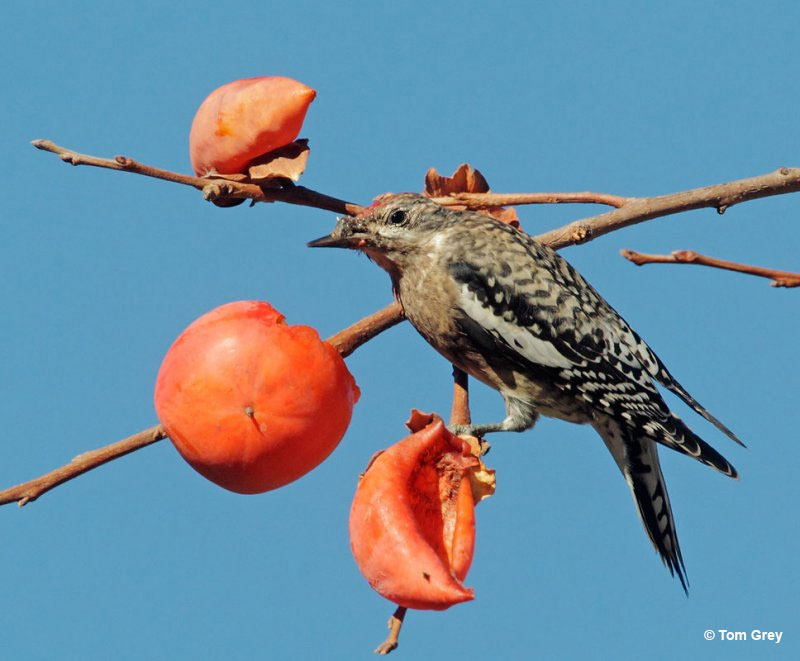
© Tom Grey
They also use this behavior when aggressively facing off with Yellow-bellied Sapsuckers of the same sex.
They’re also aggressive towards the Red-breasted Sapsucker. They seem to be pushing these birds out of their breeding range. They can be aggressive to hummingbirds that are attracted to the sap from their wells and the humans that study them.
Range (and seasonal changes)
The Yellow-bellied Sapsucker is a short-distance to long-distance migrant. These birds leave their breeding grounds in the fall to head to their wintering grounds in Mexico, the Southern U.S., Central America, and West Indies. They arrive back in the northern portions of their range in May.
Female Yellow-bellied Sapsuckers tend to migrate farther south than male Yellow-bellied Sapsuckers do.
Wing shape
Yellow-bellied Sapsuckers have long wings that extend past the end of their tail and a wingspan of 13.4 to 15.8 inches (34 to 40 centimeters). These birds fly like woodpeckers do, in a swooping manner or up-and-down bouncing.
Fun Facts
- Woodpeckers walk vertically up trees; they do this to forage for food and nest excavation. Additionally, they have strong, short legs and strong feet and claws to help them with this venture.
- The Yellow-bellied Sapsucker is unique in that they’re a migratory woodpecker. Most woodpeckers can get by on invertebrates like insects. However, these birds are so dependent on sap that they have to leave when the trees freeze up. This is because sap becomes inaccessible.
- Yellow-bellied Sapsuckers nest in cavities. The males are the ones to do most of the work. It takes them 2 to 3 weeks to excavate the cavity completely.
- The main food of Yellow-bellied Sapsucker hatchlings is insects. Sometimes, the parents will cover the insect in tree sap before giving it to the hatchling. The young will beg for food through vocalizations that can be heard 330 feet (100 meters) away.
Vocalization
The Yellow-bellied Sapsucker’s standard call is a nasal mewing/scratchy sound that is often repeated. They also have a repeated quee-ah, quee-ah, squealing call that’s often heard during the breeding season to declare territory. They also make a waa call to alert other birds to danger or when they’re disturbed.
The Yellow-bellied Sapsucker has more irregular and slower drumming than other woodpeckers.
In addition to a tree with good resonance, these birds will also drum on metal surfaces, like a cable dish or street sign, to amplify their messages. Drumming is mostly done by males during the breeding season.
Similar Species
There are a few species that closely resemble Yellow-bellied Sapsuckers. Here’s how to tell them apart.

Downy Woodpecker
At first sight, Yellow-bellied Sapsuckers may be confused with Downy Woodpeckers.
They are roughly the same size and have similar plumages, but Downy Woodpeckers only have red at the backs of their heads.
Downy Woodpeckers are slightly smaller than Yellow-bellied Sapsuckers.
Related: Types of Woodpeckers in North America
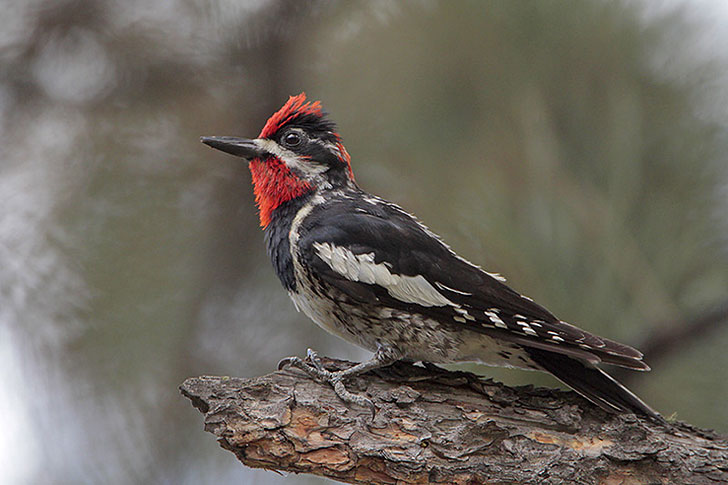
Red-naped Sapsucker
Yellow-bellied Sapsuckers and Red-naped Sapsuckers look similar, but they are easy to distinguish from each other.
Red-naped Sapsuckers are a bit darker in color. As their name hints, they have a red patch on their nape, but their underbelly is more brownish.
Frequently Asked Questions
Where do Yellow-bellied Sapsuckers live?
The Yellow-bellied Sapsucker will favor edge habitats and young forests in spring and summer. However, in their wintering grounds, these sapsuckers aren’t as picky when it comes to habitat. They inhabit bottomland hardwood forests to habitats as high as 10,000 feet. Additionally, these birds inhabit forests of pines, oaks, or hickory.
Is the Yellow-bellied Sapsucker a woodpecker?
Yes, the Yellow-bellied Sapsucker is a woodpecker. They’re smaller-sized woodpeckers that have long wings that extend past the end of their tail and straight, stout bills.
Do Yellow-bellied Sapsuckers harm trees?
Yes, Yellow-bellied Sapsuckers can harm trees. They’re girdling tree trunks when they create holes in search of sap and insects. This stops the sap from flowing to the roots. These birds feed on 400 different tree species.

